
By the end of a damp Cape winter, it’s inevitable that you’ll have at least some mould (even if you can’t see it with the naked eye) on walls, in cupboards, on windows and on your curtains and carpets.
Once mould really sets it, it can permanently stain fabrics, corrode surfaces and cause unpleasant odours.
Unfortunately, mould isn’t just unsightly. It can also trigger asthma and allergies, along with a range of other health problems.
How serious can mould get?
In December 2009, Hollywood actress Brittany Murphy died of pneumonia. Just months later, in May 2010, her screenwriter husband, Simon Monjack, also died. Experts investigated, and their conclusion? Both deaths were due to the presence of mould in the couple’s L.A. mansion.
Common household mould doesn’t typically have such dramatic effects. However, it’s best not to leave it unchecked in your home. Also, other more dangerous types of mould can grow in households.
How mould spreads
Mould, which is a micro-organism, occurs both indoors and out. Mould spores, which are too small for us to see unaided, usually enter homes through open windows, doors, air vents or air-conditioning units.
Mould can grow on just about any surface, including walls, ceilings, insulation, carpets, fabric, upholstery, wood fittings and furnishings, paper products, cardboard and even in dust.
It will grow almost anywhere where it has access to moisture – and if it’s not controlled, it can multiply and spread quickly.
The health risks associated with mould
Although some moulds are more hazardous than others, exposure to even non-pathogenic mould can cause a variety of health complications – from mild allergies to more severe issues.
People with compromised immune systems or pre-existing respiratory problems should be especially careful to limit their exposure.
Health problems commonly associated with exposure to mould include nasal congestion and sinusitis, throat irritation/coughing, eye and skin irritation, asthma and more serious (even life-threatening) allergic responses.
Less commonly, mould (especially pathogen varieties) has been associated with
- muscle and joint pain
- headaches
- anxiety, depression, fatigue and memory loss
- vomiting and diarrhoea
- visual disturbances
- infertility
- liver damage
- lung infections like fibrosis
- kidney toxicity
- cancer.
More about mould
Based on the kinds of health effects they have, moulds can be categorised as allergenic, toxigenic or pathogenic.
Allergenic moulds
These moulds generally don’t typically cause life-threatening health complications, but are problematic if you suffer from allergies or asthma. Children, in particular, are highly susceptible to mould allergies. Commonly found allergenic mould species include the Alternaria genus, which can cause hay fever; and Didymella exitialis, which can cause severe asthma.
Toxigenic moulds
Toxigenic moulds produce mycotoxins, which are harmful to all humans and animals. These chemical toxins can enter the human body through ingestion, inhalation or skin contact. Exposure to mycotoxins can cause a number of health issues, including neurological disorders and cancer.
Examples of toxigenic moulds are Stachybotrys chartarum (commonly called “black mould”), which can cause severe respiratory problems and on-going headaches; and Aspergillus flavus, which produces one of the most powerful carcinogens.
Pathogenic moulds (Mycoses)
Mycoses are moulds that cause infection in humans and animals. Although they can cause illness in healthy individuals, they more frequently affect those with weakened immune systems.
Examples of these moulds are Cryptococcus neoformans, which can cause meningitis in individuals with HIV and AIDS; and Pneumocystis jirovecii, which can cause pneumonia.
Controlling mould
A useful resource for more information about mould, along with tips for preventing and removing it, is the U.S. Center for Disease Control and Prevention site.
In the home, cleaning affected walls or ceilings with a mild bleach solution, washing fabrics at high temperature and even simply exposing items to direct sunlight can help kill and remove mould.



